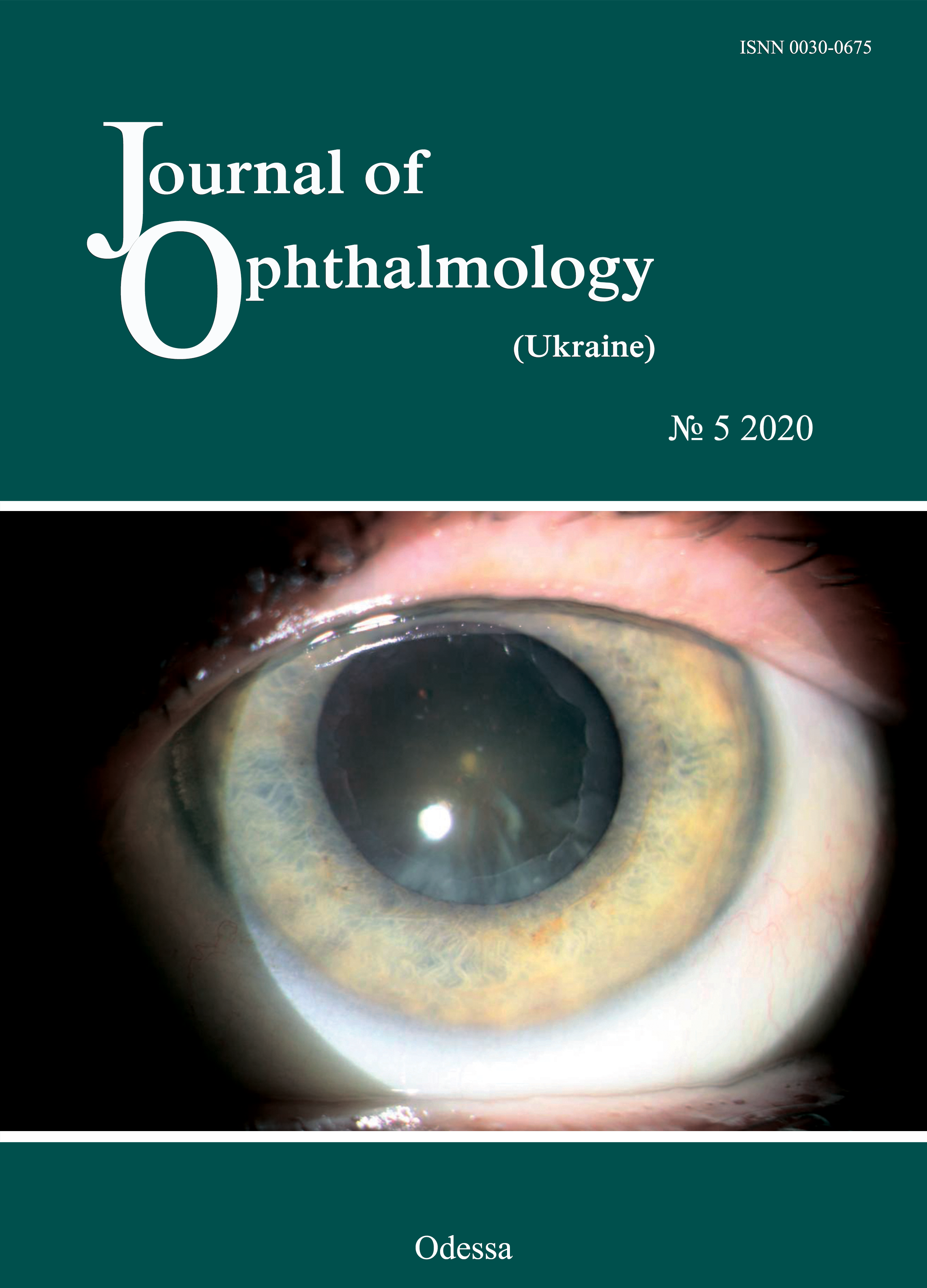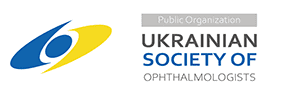Clinical, morphological, CT and MRI characteristics of anterior skull base and orbital tumors
DOI:
https://doi.org/10.31288/oftalmolzh202056274Keywords:
benign and malignant anterior skull-base tumors, epithelial lacrimal gland tumors, clinical features, CT, MRI, diagnostic techniquesAbstract
Background: Tumors of the anterior skull base and orbit (ASBOT) are more commonly epithelial malignancies arising in the nasal cavity, paranasal sinuses, and orbit, and, of ASBOT, approximately 25%-30% are diagnosed in advanced cases. Primary epithelial tumors of the orbit are located in the lacrimal gland area, and grow invasively with destruction of the roof and external wall of the orbit and intracranial and intracerebral extensions.
Purpose: To examine the clinical, morphological, computer tomography (CT) and magnetic resonance imaging (MRI) characteristics of anterior skull base and orbit tumors.
Material and Methods: One hundred and ninety-two patients with ASBOT treated at the Kolomiichenko Institute of Otolaryngology and Romodanov Neurosurgery Institute and 110 patients with epithelial lacrimal gland tumors (PELGT) treated at the Filatov Institute were included in the study.
Results: A malignant ASBOT was found in 133 patients (69.3%), and a benign, in 59 (30.7%). Most benign cases (84%) were juvenile nasopharyngeal angiofibroma, meningioma or osteoma. The most common primary location of benign ASBOT was extracranial (51% of patients), followed by skull base bone and cartilage (27%) and intracranial (22%).
Cancer neoplasms constituted 40% of malignant ASBOT. The primary location of malignant ASBOT was much more commonly extracranial (81% of patients) than skull base bone and cartilage (19%). Of the 110 patients with PELGT, 51 (46.3%) had benign tumors (benign pleomorphic adenoma, 42 (38.2%); mucoepidermoid tumor, 5 (4.5%); myxoma, 3 (2.7%); and oncocytoma, 1 (0.9%)); and 59 (53.7%), malignant tumors (adenocarcinoma, 33 (30.0%); adenoid cystic carcinoma, 18 (16.4%); and malignant pleomorphic adenoma, 8 (7.3%)).
Patient complaints were broadly categorized into cerebral, rhynologic, neuro-ophthalmologic and otologic. These complaints were found almost as common in patients with benign as with malignant ASBOT, and were characteristic also for PELGT. Clinical, CT and MRI features for various histomorphological types of benign and malignant neoplasms were described.
Conclusion: Large and even giant size is a common feature of ASBOT; this is true also for primary ASBOT diagnosed for the first time during a long asymptomatic stage. We also determined frequencies of injury to various compartments of the intra- and extra-cranial surfaces of the skull base for benign and malignant processes. Benign ASBOT were found to be more commonly located in the lateral skull base, whereas malignant ASBOT were more commonly seen within the floor of the anterior cranial fossa. There are certain grades of intracranial growth for malignant ASBOT and intracranial extension for benign ASBOT, these grades depending mostly on histobiological characteristics and disease duration. Intracranial and intracerebral extensions are the main cause of mortality in patients with PELGT.
References
1.Polishchuk MIe, Lukach EV, Opanaschenko GO. [Combined ethmoidectomy (external transnasal and transcranial frontal) for the malignant tumor of the ethmoid labyrinth]. Zhurnal vushnykh, nosovykh i gorlovyjh khvorob. 1995; 3:43-5. Ukrainian.
2.Complications of craniofacial resection for malignant tumors of the skull base: report of an International Collaborative Study. Ganly I, Patel SG, Singh B, et al. Head Neck. 2005 Jun;27(6):445-51. https://doi.org/10.1002/hed.20166
3.Daele JJ, Vander Poorten V, Rombaux P, Hamoir M. Cancer of the nasal vestibule, nasal cavity and paranasal sinuses. B-ENT. 2005;Suppl 1:87-94; quiz 95-6.
4.Origitano TC, Petruzzelli GJ, Leonetti JP, Vandevender D. Combined anterior and anterolateral approaches to the cranial base: complication analysis, avoid¬ance, and management. Neurosurgery. 2006 Apr;58(4 Suppl 2):ONS-327-36; discussion ONS-336-7.https://doi.org/10.1227/01.NEU.0000192680.48095.BD
5.Taghi A, Ali A, Clarke P. Craniofacial resection and its role in the management of sinonasal malignancies. Expert Rev Anticancer Ther. 2012 Sep;12(9):1169-76.https://doi.org/10.1586/era.12.93
6.Brovkina AF. [Diseases of the orbit: a guide for physicians]. 2nd ed. Moscow: Meditsinskoie informatsionnoie agenstvo; 2008. Russian.
7.Poliakova SI. [Epithelial lacrimal gland tumors: clinical features, prognosis and treatment]. Abstract of the Dissertation for the Degree of Dr Sc (Med). Odesa: Filatov Institute of Eye Diseases; 2011. Ukrainian.
8.Lin SC, Kau HC, Yang CF, et al. Adenoid cystic carcinoma arising in the inferior orbit without evidence of lacrimal gland involvement. Ophthalmic Plast Reconstr Surg. Jan-Feb 2008;24(1):74-6.https://doi.org/10.1097/IOP.0b013e318160c938
9.Vagefi MR, Hong JE, Zwick ОM, et al. Atypical presentations of pleomorphic adenoma of the lacrimal gland. Ophthalmic Plast Reconstr Surg. Jul-Aug 2007;23(4):272-4.https://doi.org/10.1097/IOP.0b013e3180686e63
10.Bernardini FP, Davoto MH, Croxatho JO. Epithelial tumors of the lacrimal gland: an update. Curr Opin Ophthalmol. 2008 Sep;19(5):409-13.https://doi.org/10.1097/ICU.0b013e32830b13e1
11.Nicolai P, Redaelli de Zinis LO, Facchetti F, et al. Craniofacial resection for vascular leiomyoma of the nasal cavity. Am J Otolaryngol. Sep-Oct 1996;17(5):340-4.https://doi.org/10.1016/S0196-0709(96)90022-8
12.Demiroz C, Gutfeld O, Aboziada M, et al. Esthesioneuroblastoma: is there a need for elective neck treatment? Int J Radiat Oncol Biol Phys. 2011 Nov 15;81(4):e255-61.https://doi.org/10.1016/j.ijrobp.2011.03.036
13.Maroldi R, Ambrosi C, Farina D. Metastatic disease of the brain: extra-axial metastases (skull, dura, leptomeningeal) andtumour spread. Eur Radiol. 2005 Mar;15(3):617-26.https://doi.org/10.1007/s00330-004-2617-5
14.Ichimura K. Analysis of tumor recurrence following anterior skull base surgery. Eur Arch Otorhino¬laryngol. 1998;255(3):155-62.https://doi.org/10.1007/s004050050034
15.Park MC, Goldman MA, Donahue JE, et al. Endonasal ethmoidectomy and bifrontal craniotomy with craniofacial approach for resection of frontoethmoidal osteoma causing tension pneumocephalus. Skull Base. 2008 Jan;18(1):67-72.https://doi.org/10.1055/s-2007-993046
16.Henderson JW. Orbital Tumors. 3rd ed. New York: Raven Press; 1994.
17.Kuriakose MA, Trivedi NP, Kekatpure V. Anterior skull base surgery. Indian J Surg Oncol. 2010 Apr;1(2):133-45.https://doi.org/10.1007/s13193-010-0027-5
18.Weber SM, Kim J, Delashaw JB, Wax MK. Radial forearm free tissue transfer in the management of persistent cerebrospinal fluid leaks. Laryngoscope. 2005 Jun;115(6):968-72.https://doi.org/10.1097/01.MLG.0000163335.05388.8E
19.Shah JP, Kraus DH, Bilsky MH, et al. Craniofacial Resection for Malignant Tumors Involving the Anterior Skull Base. Arch Otolaryngol Head Neck Surg. 1997 Dec;123(12):1312-7.https://doi.org/10.1001/archotol.1997.01900120062010
20.Patel SG, Singh B, Polluri A, et al. Craniofacial surgery for malignant skull base tumors: report of an international collaborative study. Cancer. 2003 Sep 15;98(6):1179-87.https://doi.org/10.1002/cncr.11630
21.Elloumi F, Boujelbene N, Ghorbal L, et al. Esthesioneuroblastoma. Bull Cancer. 2012 Dec;99(12):1197-207.https://doi.org/10.1684/bdc.2012.1642
22.Teknos TN, Smith JC, Day TA, et al. Microvascular free tissue transfer in reconstructing skull base defects: lessons learned. Laryngoscope.
23.Tsai EC, Santoreneos S, Rutka JT. Tumors of the skull base in children: review of tumor types and management strategies. Neurosurg Focus. 2002 May 15;12(5):e1.https://doi.org/10.3171/foc.2002.12.5.2
24.Currie ZL, Rose G E. Long-term risk of recurrence after intact excision of pleomorphic adenomas of the lacrimal gland. Arch Ophthalmol. 2007 Dec;125(12):1643-6.https://doi.org/10.1001/archopht.125.12.1643
25.Blitzer A, Post KD, Conley J. Craniofacial resection of ossifying fibromas and osteomas of the sinuses. Arch Otolaryngol Head Neck Surg. 1989 Sep;115(9):1112-5.https://doi.org/10.1001/archotol.1989.01860330102027
26.Carrabba GA, Dehdashti R, Gentili F. Surgery for clival lesions: open resection versus the expanded endoscopic endonasal approach. Neurosurg Focus. 2008;25(6):E7.https://doi.org/10.3171/FOC.2008.25.12.E7
27.Cheesman AD, Lund VJ, Howard DJ. Craniofacial resection for tumors of the na¬sal cavity and paranasal sinuses. Head Neck Surg. Jul-Aug 1986;8(6):429-35.https://doi.org/10.1002/hed.2890080606
28.Emery E, Alaywan M, Sindou M. [Respective indications of orbital and/or zygomatic arch removal combined with fronto-pteriono-temporal approaches. 58 cases]. Neurochirurgie. 1994;40(6):337-47. French.
29.Falcioni M, Taibah A, De Donato G, et al. [Lateral approaches to the clivus]. Acta Otorhinolaryngol Ital. 1997 Dec;17(6 Suppl 57):3-16. Italian.
30.Uttley D. Transfacial approaches to the skull base. Adv Tech Stand Neurosurg. 1997;23:145-88.https://doi.org/10.1007/978-3-7091-6549-2_3
31.Sartoris A, Cortesina G, Busca GR. [Anterior craniofacial resection in the treatment of malignant nasal-paranasal sinus tumors with intracranial extension]. Acta Otorhinolaryngol Ital. 1991;11(3):317-27.
32.van Buren JM, Ommaya AK, Ketcham AS. M. Ten years' experience with radical com¬bined craniofacial resection of malignant tumors of the paranasal sinuses. J Neurosurg. 1968 Apr;28(4):341-50.https://doi.org/10.3171/jns.1968.28.4.0341
33.Cantrell RW, Ghorayeb ВY, Fitz-Hugh GS. Esthesioneuroblastoma: diagnosis and treat¬ment. Ann Otol Rhinol Laryngol. Nov-Dec 1977;86(6 Pt 1):760-5.https://doi.org/10.1177/000348947708600608
34.Simal Julián JA, Miranda Lloret P, Cárdenas Ruiz-Valdepeñas E, et al. Esthesioneuroblastoma. Transcribiform-transfovea ethmoidalis endonasal expanded approach. Technical note. Neurocirugia (Astur). 2012 Jul;23(4):157-63.https://doi.org/10.1016/j.neucir.2011.10.001
35.Jethanamest D, Morris LG, Sikora AG, Kutler DI. Esthesioneuroblastoma: a population-based analysis of survival and prognostic factors. Arch Otolaryngol Head Neck Surg. 2007 Mar;133(3):276-80.https://doi.org/10.1001/archotol.133.3.276
36.Pendleton C, Raza SM, Boahene KD, Quinones-Hinojosa A. Transfacial approaches to the skull base: the early contributions of Harvey Cushing. Skull Base. 2011 Jul;21(4):207-14.https://doi.org/10.1055/s-0031-1275631
Downloads
Published
How to Cite
Issue
Section
License
Copyright (c) 2025 О. І. Паламар, Е. В. Лукач, А. П. Гук, А. П. Малецький, С. І. Полякова, О. В. Кравець, Ю. О. Сережко, Д. І. Оконський

This work is licensed under a Creative Commons Attribution 4.0 International License.
This work is licensed under a Creative Commons Attribution 4.0 International (CC BY 4.0) that allows users to read, download, copy, distribute, print, search, or link to the full texts of the articles, or use them for any other lawful purpose, without asking prior permission from the publisher or the author as long as they cite the source.
COPYRIGHT NOTICE
Authors who publish in this journal agree to the following terms:
- Authors hold copyright immediately after publication of their works and retain publishing rights without any restrictions.
- The copyright commencement date complies the publication date of the issue, where the article is included in.
DEPOSIT POLICY
- Authors are permitted and encouraged to post their work online (e.g., in institutional repositories or on their website) during the editorial process, as it can lead to productive exchanges, as well as earlier and greater citation of published work.
- Authors are able to enter into separate, additional contractual arrangements for the non-exclusive distribution of the journal's published version of the work with an acknowledgement of its initial publication in this journal.
- Post-print (post-refereeing manuscript version) and publisher's PDF-version self-archiving is allowed.
- Archiving the pre-print (pre-refereeing manuscript version) not allowed.












